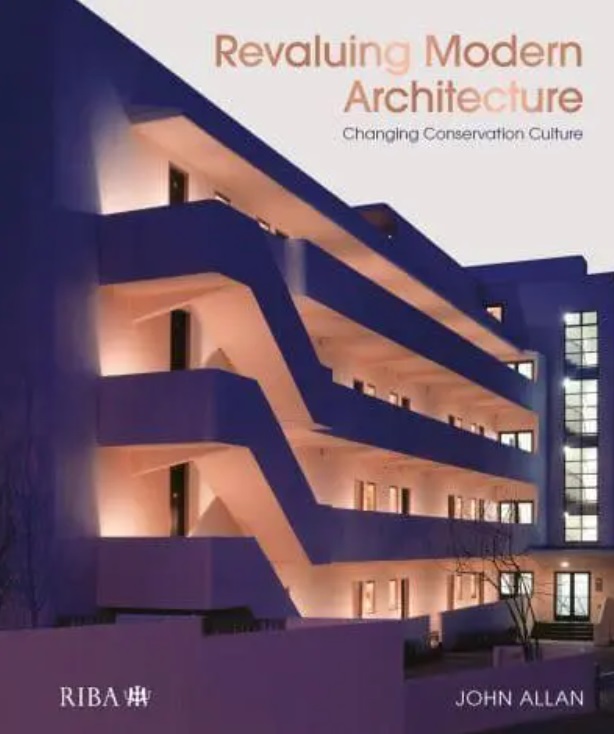Revaluing Modern Architecture: changing conservation culture
Revaluing Modern Architecture: changing conservation culture, John Allan, RIBA Publishing, 2022, 230 pages, colour and black-and-white illustrations, hardback.
In this important book, John Allan, founder of Avanti Architects, explores the changing culture around conserving Modern buildings and the climate emergency. From a bleak picture in the 1970s, when virtually all postwar architecture was dismissed as worthless, there now exists a growing acceptance in terms of statutory recognition, technical understanding and historic significance of these buildings; even if Modern heritage in the UK still suffers from ignorance, controversy and neglect.
To throw light on the problems that he finds, Allan investigates some of the anomalies that exist in the application of listing criteria. These include the principles of selection for listing, where a new criterion regarding the functionality of Modern buildings and whether they fulfil the original brief was introduced by the government. This vital test of specialness for more recent buildings, something that would be ridiculous for older buildings, was instrumental in the refusal to list Pimlico School and Robin Hood Gardens, both buildings of exceptional interest that were lost as a result. He also highlights failures, such as the poor standards of maintenance that have been a major factor in the deterioration of their fabric.
In addition, an analysis of the protection of Modern buildings that have been listed raises questions about how harm is measured where alterations are proposed, and whether the provisions in the National Planning Policy Framework and Historic England’s Conservation Principles are being applied in practice. Case studies such as the Commonwealth Institute, Park Hill, Sheffield and Balfron Tower, where extensive changes have been permitted, suggest that sometimes they are not. In the case of the latter, he also questions how the loss of public housing on such a scale could be condoned.
Regarding listing, Allan observes that ministers’ reasons for their decisions have not always been transparent or based on statutory criteria. He refers (in a footnote) to a statement by Simon Thurley, the former chief executive of English Heritage, that ‘late-20th-century buildings are normally functionally inflexible’. Among professional weaknesses Allan highlights the lack of knowledge among planners and conservation officers of modern architectural heritage.
Although the book is measured in tone and optimistic overall, it is in essence a call for action. Having identified the weaknesses in the system, Allan sets out a ‘new paradigm’ for the future. The aim is to revalue Modern buildings and make them useful. As elsewhere in the book, he uses case studies to demonstrate his points, and shows how reusing existing buildings can often be cheaper and faster than new build, more energy efficient, less socially disruptive and more environmentally friendly.
It is the environmental argument that offers the most compelling reason for such revaluation, with the rapidly changing circumstances around climate change making the case for adaptation rather than demolition the norm, and the spirit of sustainability replacing that of functionalism.
In conclusion, this is a book that should be read by all those involved in building conservation, both through the regulatory process and architectural practice. Populated with fine photographs of major projects, mostly carried out by the author, it demonstrates his view that ‘the enduring appeal of the Modern Movement, over and above its aesthetic attractions, was always its egalitarianism, its social commitment, its vast sense of possibility,… it is upon their widening recognition and celebration that its survival… will ultimately depend’.
This article originally appeared as: ‘Making buildings useful’ in the Institute of Historic Building Conservation’s (IHBC’s) Context 177, published in September 2023. It was written by Peter de Figueiredo, reviews editor of Context.
--Institute of Historic Building Conservation
Related articles on Designing Buildings
IHBC NewsBlog
Old Sarum fire in listed (& disputed) WW1 Hangar - Wiltshire Council has sought legal advice after fire engulfed a listed First World War hangar that was embroiled in a lengthy planning dispute.
UK Antarctic Heritage Trust launches ‘Virtual Visit’ website area
The Trust calls on people to 'Immerse yourself in our heritage – Making Antarctica Accessible'
Southend Council pledge to force Kursaal owners to maintain building
The Council has pledged to use ‘every tool in the toolbox’ if urgent repairs are not carried out.
HE’s Research Magazine publishes a major study of the heritage of England’s suburbs
The article traces the long evolution of an internal programme to research 200 years of suburban growth
IHBC Context 183 Wellbeing and Heritage published
The issue explores issues at the intersection of heritage and wellbeing.
SAVE celebrates 50 years of campaigning 1975-2025
SAVE Britain’s Heritage has announced events across the country to celebrate bringing new life to remarkable buildings.
IHBC Annual School 2025 - Shrewsbury 12-14 June
Themed Heritage in Context – Value: Plan: Change, join in-person or online.
200th Anniversary Celebration of the Modern Railway Planned
The Stockton & Darlington Railway opened on September 27, 1825.
Competence Framework Launched for Sustainability in the Built Environment
The Construction Industry Council (CIC) and the Edge have jointly published the framework.
Historic England Launches Wellbeing Strategy for Heritage
Whether through visiting, volunteering, learning or creative practice, engaging with heritage can strengthen confidence, resilience, hope and social connections.















